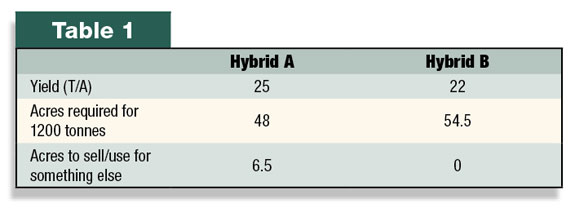For dairy producers, the decision of which hybrid or hybrids to plant in 2012 can have significant financial implications.
Most hybrid decisions will be made on Canadian dairy farms prior to the end of 2011. The decisions made this fall will impact the crop producers have to plant, manage and harvest in 2012 – and will have the greatest impact on milk cheques for most of 2013.
Selecting the best hybrid for each individual operation has never been more important than it is today.
With the increasing popularity of corn silage in the ration, due to its ability to put up large tonnages of quality, consistent feed, hybrid selection has become more critical.
Corn silage represents a significantly higher portion of the ration than it has in the past. With crop and commodity prices the way they are today and are predicted to be over the next few years, making the most of every acre of land we are able to crop is crucial.
Differences do exist among commercial corn hybrids for yield, starch levels and NDF digestibility. Many seed companies are developing forage quality profiles of their corn hybrids.
Silage hybrids should have high forage yields, high starch levels, low fibre levels and highly digestible stover.
The best silage hybrids have high grain yields, because grain is so highly digestible and accounts for upwards of 65 percent of the energy in corn silage.
However, ranking for top-yielding hybrids used for silage may vary based on differences in fibre digestibility and grain-to-stover ratio.
Findings of the University of Wisconsin Corn Silage Consortium have led Dr. Joe Lauer, Wisconsin state extension corn agronomist, to suggest to dairy producers that hybrid selection for corn silage should begin by identifying a group of hybrids adapted to the growing environment and maturity, along with standability, disease resistance and drought tolerance needs unique to the grower’s conditions.
This group of agronomically adapted hybrids should next be evaluated for silage yield performance. Many studies have shown that grain yield is a good general indicator of whole-plant yield; that is, high grain-yielding hybrids tend to have high silage yield.
However, within the high grain-yielding group there can be differences in whole-plant yield and fibre digestibility, reinforcing the need to have silage data available on these hybrids. In simpler terms, a good silage hybrid has to first be a good grain hybrid, but not all grain hybrids make good silage hybrids.
Take a second to consider the whole-farm implications of something as simple as silage yield when making hybrid selection decisions.
For the sake of having an example, let’s do some quick penciling for a 100-cow milking operation. This particular operation puts up their corn silage at 65 percent moisture and feeds a forage ration that is 60:40 corn silage:haylage on a dry matter basis.
Their intakes are consistently 24 kilograms of dry matter and 70 percent of their total ration is forages.
Based on these numbers, this producer needs to put away 1,051 tonnes of corn silage each year. Let’s make 1,200 tonnes to account for shrink and other losses.

Consider now two different hybrids, A and B, and what the effect of a 3-tonne-per-acre yield difference between them can have on an individual enterprise (see Table 1). This exercise assumes the hybrids are identical in terms of nutrition:
Let’s now take that 6.5 acres that we no longer need for corn silage, harvest them as dry corn and sell them on the open market.
With a yield of 140 bushel per acre and a cash price of $6 per bushel, the producer who chose to grow hybrid A is left with an additional cropping income of $5,460.
The great thing for this producer is the only additional cost involved with this difference in income was the time and information required to make a better decision for his operation.
In order to make this decision, a producer requires data. It is not valid to primarily attribute hybrid genetics to the cause of nutritional differences when comparing hybrids grown on different farms.
This is why seed companies and university plots only compare hybrids grown in the same location (side by side).
One can draw an analogy to proving bulls. The A.I. industry uses statistical procedures to factor out genetics (of the dam) and environment (housing, hygiene, nutrition, etc.) to sort out production differences among bull daughters born into herds across the country.
This is possible because there is no growing environment limitation to where a bull’s daughter can be born.
We can also have enough daughters, born into enough herds that we can, in effect, zero out the non-genetic effects of production to arrive at the genetic transmitting ability of the bull.
This is not possible with corn genetics because of growing environment suitability limitations. Therefore, seed companies have to compare hybrids grown next to each other, across multiple plots (so they all receive the same environment).
It is also important to compare hybrids within the same maturity, seed treatments, technology segment and planting populations (e.g., low populations will result in lower starch levels and higher NDF digestibility).
The bottom line here is that comparing your feed sample to other feed samples in the area, from friends or from your nutritionist is not a good way to select a hybrid.
Making the best decision for each individual operation is no simple task. The process requires knowing what your acres need in terms of maturity, agronomic traits and disease resistance.
Once that list is created, yield, starch levels and, finally, digestibility should all be taken into consideration before making the final choices.
Work with your seed suppliers to get their recommendations on hybrids and then ask for the supporting data to show that their hybrid is a good fit for your operation.
With higher corn silage levels in the diet and high crop prices, hybrid selection has never meant more to your farm. Take the time to research and get it right for 2012. PD
References omitted due to space but are available upon request.

- Robert Larmer
- Consultant
- Pioneer Hi-Bred International – Canada









